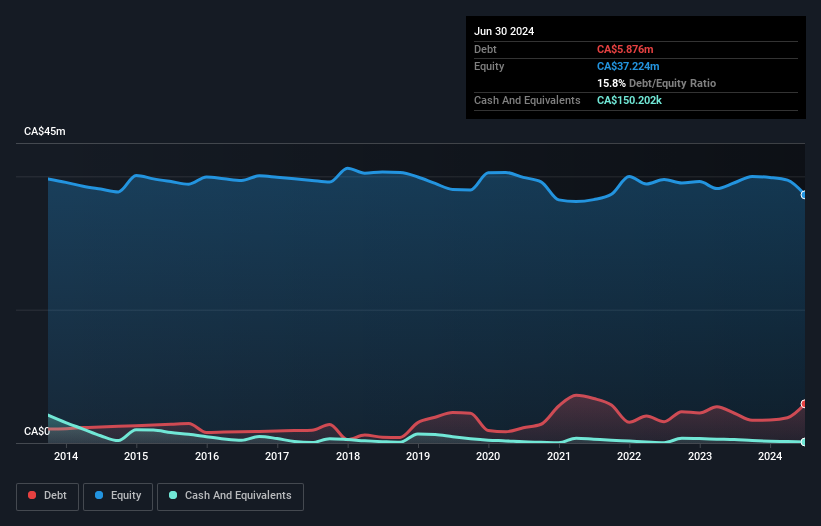Warren Buffett famously said, 'Volatility is far from synonymous with risk.' When we think about how risky a company is, we always like to look at its use of debt, since debt overload can lead to ruin. We can see that Oceanic Iron Ore Corp. (CVE:FEO) does use debt in its business. But the real question is whether this debt is making the company risky.
What Risk Does Debt Bring?
Generally speaking, debt only becomes a real problem when a company can't easily pay it off, either by raising capital or with its own cash flow. In the worst case scenario, a company can go bankrupt if it cannot pay its creditors. However, a more usual (but still expensive) situation is where a company must dilute shareholders at a cheap share price simply to get debt under control. By replacing dilution, though, debt can be an extremely good tool for businesses that need capital to invest in growth at high rates of return. When we examine debt levels, we first consider both cash and debt levels, together.
View our latest analysis for Oceanic Iron Ore
What Is Oceanic Iron Ore's Debt?
You can click the graphic below for the historical numbers, but it shows that as of June 2024 Oceanic Iron Ore had CA$5.88m of debt, an increase on CA$4.47m, over one year. However, because it has a cash reserve of CA$150.2k, its net debt is less, at about CA$5.73m.

How Healthy Is Oceanic Iron Ore's Balance Sheet?
Zooming in on the latest balance sheet data, we can see that Oceanic Iron Ore had liabilities of CA$7.05m due within 12 months and liabilities of CA$467.8k due beyond that. On the other hand, it had cash of CA$150.2k and CA$6.2k worth of receivables due within a year. So its liabilities outweigh the sum of its cash and (near-term) receivables by CA$7.36m.
This deficit is considerable relative to its market capitalization of CA$10.5m, so it does suggest shareholders should keep an eye on Oceanic Iron Ore's use of debt. Should its lenders demand that it shore up the balance sheet, shareholders would likely face severe dilution. There's no doubt that we learn most about debt from the balance sheet. But it is Oceanic Iron Ore's earnings that will influence how the balance sheet holds up in the future. So when considering debt, it's definitely worth looking at the earnings trend. Click here for an interactive snapshot.
Given its lack of meaningful operating revenue, investors are probably hoping that Oceanic Iron Ore finds some valuable resources, before it runs out of money.
Caveat Emptor
Over the last twelve months Oceanic Iron Ore produced an earnings before interest and tax (EBIT) loss. Indeed, it lost CA$568k at the EBIT level. Considering that alongside the liabilities mentioned above does not give us much confidence that company should be using so much debt. So we think its balance sheet is a little strained, though not beyond repair. However, it doesn't help that it burned through CA$283k of cash over the last year. So suffice it to say we do consider the stock to be risky. There's no doubt that we learn most about debt from the balance sheet. However, not all investment risk resides within the balance sheet - far from it. We've identified 3 warning signs with Oceanic Iron Ore (at least 2 which shouldn't be ignored) , and understanding them should be part of your investment process.
When all is said and done, sometimes its easier to focus on companies that don't even need debt. Readers can access a list of growth stocks with zero net debt 100% free, right now.
New: AI Stock Screener & Alerts
Our new AI Stock Screener scans the market every day to uncover opportunities.
• Dividend Powerhouses (3%+ Yield)
• Undervalued Small Caps with Insider Buying
• High growth Tech and AI Companies
Or build your own from over 50 metrics.
Have feedback on this article? Concerned about the content? Get in touch with us directly. Alternatively, email editorial-team (at) simplywallst.com.
This article by Simply Wall St is general in nature. We provide commentary based on historical data and analyst forecasts only using an unbiased methodology and our articles are not intended to be financial advice. It does not constitute a recommendation to buy or sell any stock, and does not take account of your objectives, or your financial situation. We aim to bring you long-term focused analysis driven by fundamental data. Note that our analysis may not factor in the latest price-sensitive company announcements or qualitative material. Simply Wall St has no position in any stocks mentioned.
About TSXV:FEO
Oceanic Iron Ore
An exploration stage company, engages in the acquisition and exploration of iron ore properties in Québec, Canada.
Medium-low risk with imperfect balance sheet.
Market Insights
Community Narratives


Recently Updated Narratives


Alphabet: The Under-appreciated Compounder Hiding in Plain Sight


MINISO's fair value is projected at 26.69 with an anticipated PE ratio shift of 20x


The Quiet Giant That Became AI’s Power Grid
Popular Narratives


The company that turned a verb into a global necessity and basically runs the modern internet, digital ads, smartphones, maps, and AI.


MicroVision will explode future revenue by 380.37% with a vision towards success



